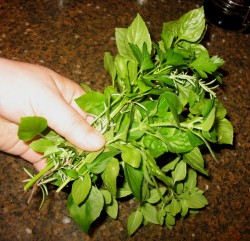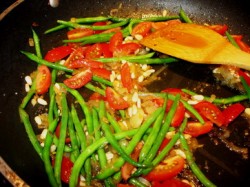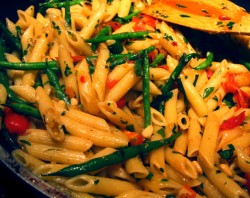Fresh And Local Ingredients Make Summer Pasta Special
I am lucky to live where I do.
Many city dwellers would be confused to hear me say that; after all, I live in a very small town in the middle of a rural Appalachian Ohio county that has a high unemployment rate and all of the attendant problems which that entails.
However, I am lucky to live in a place with such a thriving local food community that I can go to my farmer’s market twice a week and pick out some of the freshest, tastiest produce imaginable, and bring it home in order to make healthy, low-cost meals for my family.
I am also lucky to have the ability to grow some small percentage of my own food: right now that ability is limited to my deck garden, but I am able to grow most of my own herbs, some chiles and a good amount of cherry and miniature plum tomatoes.
On nights like tonight, I am able to combine the foods and seasonings I grow with produce from the farmer’s market with some staples from the grocery store and make a meal that is amazingly fresh, delicious and full of vitamins, minerals and all of those good things that we want our food to possess.
Tonight, I combined some haricot vert–those slender, graceful French princesses of the green bean world–that I picked up from the market yesterday with onions and garlic from the same farmer, added my own miniature plum tomatoes, chiles and fresh herbs, then included olive oil, lemon zest and juice, dry sherry, pine nuts, parmesan cheese and pasta from the grocery store and came up with a really light dish that is perfect for a hot summer night.
Haricot vert are beautiful little beans–very sweet and delicate in flavor, tender little twigs of verdant goodness. Their texture is tender, too–they overcook easily, so instead of pre-blanching them, I decided to saute them in the pan along with the other ingredients of the pasta sauce. This way, not only were they less likely to become overcooked and rubbery, they picked up the intense flavor of the caramelized onions, garlic, chile and lemon zest, which perfectly complimented the green grassiness of the beans.
When I saw them at the farmer’s stand, I exclaimed with joy, “Haricot vert!” laughing with delight. The farmer smiled broadly and said, “Yep–they are good little things–they’ll spoil you for other beans.” As he measured them out and took my money, though, he confided, “You know, they are a lot of work–picking enough to fill a pint or quart basket takes a lot longer than picking regular beans. They are -so- small!”
Well, yes, they are troublesome, and thus are more expensive than regular green beans, but the farmer is right–they will spoil the palate for regular beans in a heartbeat. Once you have tasted them properly cooked, their flavor and texture will haunt your tastebuds forever more, until you can have them again. After the terracing is done, if I grow beans in the backyard, it is likely to be these pretty little ones.
When I prepare them for cooking, you will notice I leave the tails on and do not string them. That is because there is no string to speak of, and the pointy little tails look elegant on the end of the beans. I do “top” them, though–snapping off any remaining stem on the top edge of the bean, so as to avoid the tough stalk there. I also left them whole–they are very attractive when presented that way, and they echo the shape of the penne perfectly. Presenting regular string beans this way, even the so-called “stringless” varieties is not as prudent a choice. They always look coarse, and often there are tough stringy bits that ruin the experience of eating the beans–one should not eat and floss one’s teeth at the same time.
It just should not be done.
In deference to my training in Chinese cooking, when I cut up the small plum tomatoes, I cut them in a similar shape to the beans and penne–I cut them in half longways, then slice each half into long, skinny thirds. This keeps the dish looking pretty, and it helps expose more of the flesh of the tomatoes to the heat of the pan so that they melt partway into the sauce. I could have skinned the tomatoes by blanching them briefly in boiling water then plunging them into ice water, but truthfully, I wanted some of them to melt into the sauce, and others of them to remain distinct. The tomato skins of the ones that melted did not bother me, or Zak, but if they would bother you, feel free to peel the tomatoes first.
As for the seasonings–the chile, garlic, onions and herbs–all of them are locally grown, here in Athens county. The herbs and chiles were so local as to come from my deck garden, where three kinds of basil, two kinds of sage, several rosemaries, oregano, Italian parsley, tarragon, thyme, chiles and tomatoes thrive in great abundance. The onions and garlic come from the farmer’s market, and as a consequence, have a very strong, very clear flavor. Really fresh hardneck garlic such as what is grown here has a much better, more nuanced flavor than that softneck garlic that is stored for months and sold in the grocery store. I find that when I use it, I can use less of it, because it is so fresh. The same goes for the onions.
Since this impromptu pasta dish contains local spices (garlic, onion and chile) and herbs, and is based heavily on local produce, it is my entry for The Spice is Right V: Fresh and Local. I have received a few other entries, all of which look and sound delicious, so I look forward to hearing from participants around the world, to see what is fresh and local in their regions and in their kitchens.
Penne With Haricot Vert, Tomatoes and Caramelized Onions
Ingredients:
3 tablespoons olive oil
2 small or 1 medium yellow onions, cut in half, peeled and thinly sliced
generous pinch salt
zest of 1 lemon, minced
2 small, very hot chile peppers, such as Thai bird chiles, minced (or, to taste)
2 tablespoons raw pine nuts (optional–but they really -are- good in this)
1/4 cup dry sherry, divided into two halves
3 cloves garlic, peeled and minced
1 teaspoon butter, optional
1/2 pint haricot vert, topped, but with the tails left on, rinsed and thoroughly dried
1 cup small plum, pear or cherry tomatoes, cut into thin quarters or sixths
juice of 1 lemon
3/4 pound penne pasta, cooked al dente and drained
1/2 cup mixed minced fresh herbs (I used Greek columnar basil, Greek oregano, Blue Lady rosemary, and Italian parsley)
1/4 cup freshly shredded parmesan cheese (plus extra to garnish or for diners to add on their own)
Method:
Heat olive oil in a wide, deep skillet on medium flame. Add onions, and sprinkle with salt, and cook, stirring until they go medium brown and limp. Add lemon zest, chile, and pine nuts, and keep cooking, stirring, until the lemon zest and pine nuts brown slightly.
Add half of the sherry, and the garlic and cook, stirring, until the alcohol evaporates and the garlic is fragrant. Add butter, if you are going to use it at this time and allow it to melt.
Add haricot vert, and cook, stirring, until they deepen in color slightly. Add tomatoes, and second half of sherry, the lemon juice and cook, stirring until tomatoes just begin to break down.
Add penne and half of the herbs, and the cheese. Cook, stirring, to incorporate the pasta and sauce thoroughly. At this time the haricot should be tender-crisp, the onions should be dark brown and fully caramelized, the pine nuts should be toasted, the cheese should be melting and making everything cling to the pasta. (If your pasta seems too dry at this point, you can do several things. Add a tiny sloosh –about 1/8 of a cup– of the starch-laden pasta cooking water, a tiny bit more of sherry or some more lemon juice. However, if your tomatoes are juicy, this should not be a problem.) When this happens, taste for salt, correct seasoning if necessary, stir in the rest of the herbs and turn into a warmed serving bowl and sprinkle again with some extra parmesan cheese.
This is a great light supper with a fresh salad tossed with either a lemon-olive oil dressing or a balsamic vinagrette.
6 Comments
RSS feed for comments on this post.
Sorry, the comment form is closed at this time.
Powered by WordPress. Graphics by Zak Kramer.
Design update by Daniel Trout.
Entries and comments feeds.







Mmmm…I’m a bit jealous hearing about all of your delicious, fresh, local-grown produce. It’s not impossible to find fresh and semi-locally grown vegetables in Los Angeles, it’s just that they get hauled in from counties away. I always suspect that produce, herbs, etc. purchased in our farmer’s markets has a thin coating of car exhaust on them! I do grow my own herbs but I suffer from a lack of flat land that I can grow too many veggies on.
Your pasta looks and sounds delicious. The colors are gorgeous. Thanks for the great post.
Comment by Kevin — July 28, 2006 #
Hi Barbara, your post reminded me of living in Taiwan. Farmer’s markets were absolutely everywhere in my very urban, very populated, city. Most of them ran from about 2 to 7 daily, so I had fresh produce whenever I wanted it. Trips were spontaneous, and I bought whatever I felt like eating for that day only. It’s a funny sort of reverse process here in North America. There certainly are farmer’s markets in the cities, but they’re few and far between, and carefully scheduled. If you miss the exact day, it’s off to the supermarket for you, and whatever you buy has to be planned to last the week.
Comment by Lea — July 29, 2006 #
What an adventerous dish! Carmelized onions and pasta never really connected in my head, but now I feel that I should be adventerous too and give it a try. And, I am very jealous of your twice a week farmers markets! Glad to see you are making good use of them!
Comment by risingsunofnihon — July 29, 2006 #
You are welcome, Kevin–as I said in the post, I am truly blessed in where I live.
Lea–I wish we could support an every day farmer’s market! But, I think that Americans are not used to marketing every day for fresh produce the way the Chinese and Europeans are, so it wouldn’t work here. What a shame, huh? We wouldn’t need such big refrigerators if we shopped every day–but on the other hand, I cannot imagine most Americans taking that kind of time every day, either.
Sigh. Too bad, too.
Risingsun–I love the market and have to go at least once a week, but in the summer, it is almost always twice a week! Caramelized onions give a lot of flavor to pasta–you can do a great pasta sauce with caramelized onions and sauteed mushrooms as the base. You could add some cheese or cream and sherry–and it would be great on its own. Or, add a bit of prosciutto, bacon or pancetta for a bit of protein and to make it even richer in flavor.
Comment by Barbara — August 1, 2006 #
Barbara,
My local Farmers Market was exploding with bounty today and I thought of this post. I bought up some necesarry provisions and tried this recipe out. I altered it by adding baby eggplants, summer squash, and I used Qunioa elbows instead of penne. I also had a field mix salad that included edible flowers and I tossed it with some olive oil and balsamic vinegar. All in all it was super tasty and I thank you for the recipe.
Unfortunately I didn’t get the onions to caremelize AT ALL. This was probably because I was trying to cook them at the same time as the squash and eggplant, but then I’ve never been able to carmelize onions very succesfully. Shrug.
Comment by Benjamin — August 6, 2006 #
To caramelize onions, Benjamin, you must start them alone, with butter or olive oil. Plenty of it.
Put them on medium heat, and cook, stirring until they turn transparent.
Then, sprinkle with salt–how much depends on how many onions you are cooking. But the salt is the key–not only does it season your final dish, it pulls the liquid out of the onions, and helps it boil away.
It is only when most of the moisture is gone from the onions, that they sugars in them will caramelize, turning golden, then brown, then reddish. Once the onions are a brown, you can add the other ingredients and continue cooking.
Eggplant and squash both have a lot of moisture. If you cook them with the onions at the same time, the onions will never get dry enough to caramelize.
Comment by Barbara — August 6, 2006 #